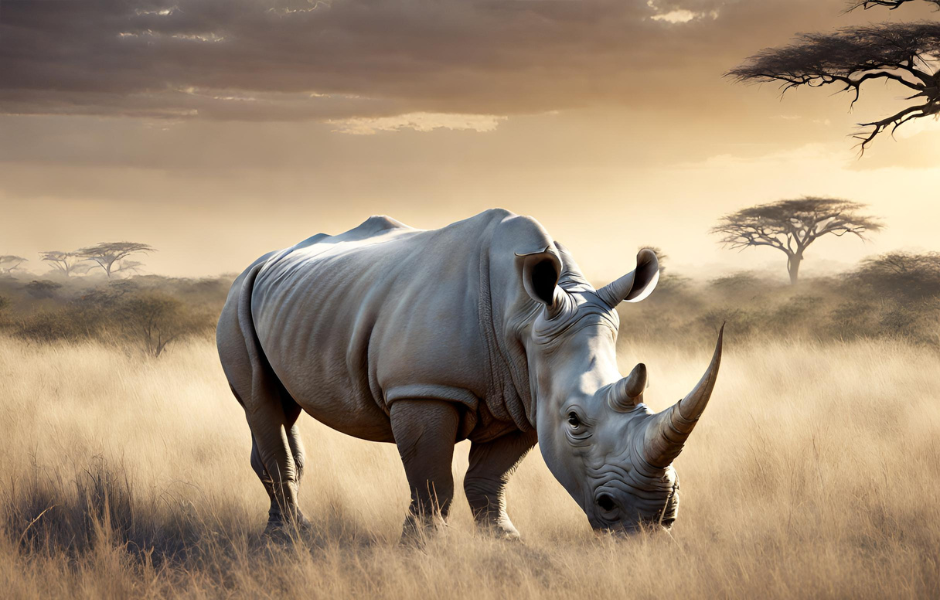
Any safari animal toys and collection would not be complete without the white rhino figurine in the pack. White rhinoceros live in the grasslands and savannas across southern Africa. It is one of the largest mammals on earth and is also known as the square-lipped rhinoceros. This species is a herbivore although they may look intimidating with their appearance and large size. A white rhino can weigh up to 2.5 tons and grow to 6 feet tall at the shoulder.
Safari Ltd. White Rhino Toy Figurine

#CommissionsEarned
The features of the Safari Ltd white rhino figurine include:
- Part of the Wild Safari Wildlife collection of educational animal models
- Approximate dimensions of 5.75 inches long and 2.5 inches tall
- Realistic and precise details
- Crafted and painted by experts
- Created using non-toxic and BPA-free materials
- Durable
- Suitable for kids ages 3 and up
10 Fun Facts About White Rhinoceros
- The elephant is the largest mammal on land. The white rhino is the second.
- White rhinos are big grazers. They can easily eat up to 150 pounds of grass daily.
- They have a big front horn on their snouts with a smaller one behind it.
- A white rhino can live up to 4 decades although some have survived beyond that especially for those in captivity.
- They are incredibly social animals and can often be seen hanging out in groups called “crashes.”
- White rhinos can hear and smell well which help to make up for their poor eyesight.
- They can run up to 30 miles per hour although they may look clumsy with their large size.
- They are also heavy animals. The females are lighter in weight but a bull can weigh up to 5,000 lbs.
- Human hair and nails are made up of keratin which is also the same material that make up a white rhino’s horns.
- The calf of a white rhino can weigh up to 150 lbs at birth.
Did The White Rhino Go Extinct?
The Northern White Rhino is the one that is critically endangered. There are only 2 Northern White Rhinos left in the world and both are females. Habitat loss and poaching are the main culprits that have led to the current situation. This is a real pity as these gentle-natured animals were once commonly found in the grasslands of Africa. In fact, the last male Northern White Rhino passed away in 2018 which is heartbreaking. Scientists are doing all they can to prevent white rhinos from going extinct at the moment and efforts include In vitro fertilization (IVF).
The Southern White Rhino has a much healthier outlook in terms of numbers compared to the Northern species. But who would have guessed that they were also on the brink of extinction at one point in the 1900s? From around 50 of them to an estimated population of 16,000 to 18,000 today, much work have gone into protecting and preserving these animals. Thanks to conservation efforts that their population has increased significantly over the decades.
Why Are They Endangered?
White rhinos are endangered due to various reasons. Development has resulted in many animals losing their natural habitat and this includes the white rhinos. As human creep into their living space to farm, urbanize, as well as to build infrastructure, their habitat is inevitably destroyed.
In addition to habitat loss, poaching is another significant threat to their survival. Their horns are highly sought after especially in some cultures that use them as a cure for ailments. The high price and rarity also means they are a form of status symbol. This demand naturally gives rise to the wildlife trade and the result is a significant decline in the animal’s population.
Conservation efforts are being implemented to help protect the remaining white rhinos. One of the most effective ways is through direct protection. This involves monitoring the rhinos, tracking their movements, and deterring poachers. This is where rangers come in and they are employed and trained to protect these animals which could be a harsh and dangerous job at times.
Another way is through habitat restoration. White rhinos require vast areas of grasslands to survive. By restoring degraded habitats and creating new protected areas, we can provide a safe haven for these animals to thrive.
Finally, education and awareness campaigns are crucial in changing people’s attitudes towards these animals. By engaging local communities and raising awareness about the importance of protecting white rhinos, illegal trade on the horns could be reduced which will then ensure their long term survival.
Lifespan
How long a white rhino lives depends on a number of factors. Although 40 years is their typical lifespan, their life is often cut short in the wild due to poaching and a loss of habitat. This differs from those in captivity which often enjoys the best care from humans. Hence, this group will tend to live a little longer. At the very least, there are no threats to their lives unlike those in the wild which have to contend with illegal hunters and urbanization. While we may have little control over genetic factors and the environment, it is unfortunate that human activities also play a role in determining a white rhino’s lifespan.
Once a female white rhino reaches 6 years old and thereabouts, she is ready for reproduction. Comparatively, the males will need to be a few years older before they can breed. Female rhinos are capable of getting pregnant and delivering a calf every 2 to 3 years.
Breeding happens through a courtship ritual that involves the male following the female around and making vocalizations to indicate his interest. The male will also engage in a behavior known as “flehmen,” where he curls his upper lip and inhales the female’s scent to assess her reproductive status. If she is willing, she will permit the male to mount her. The gestation period is around 16 months and white rhinos typically give birth to a single calf. This species are known for being protective mothers and will defend their calves against any potential threats.

#CommissionsEarned



Leave a Reply